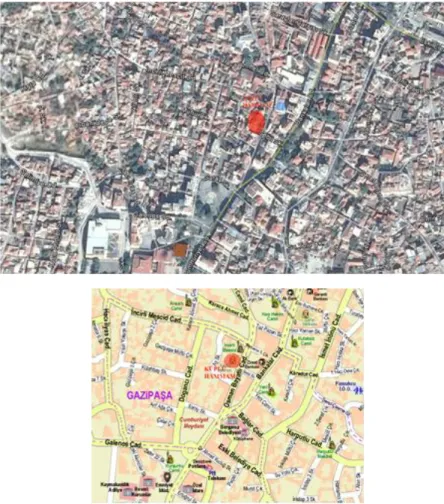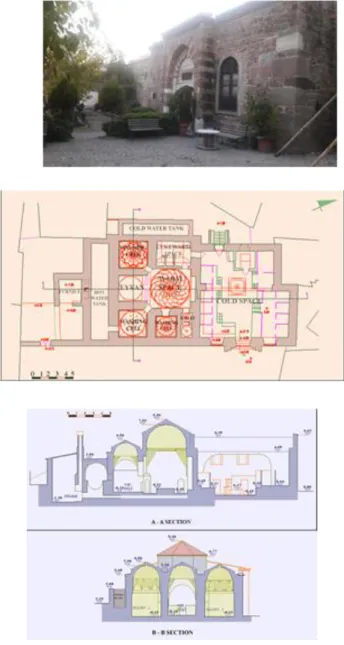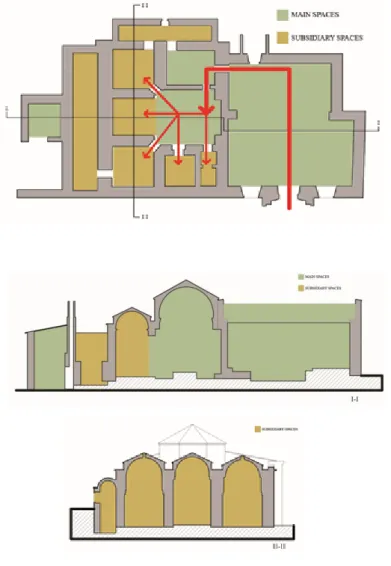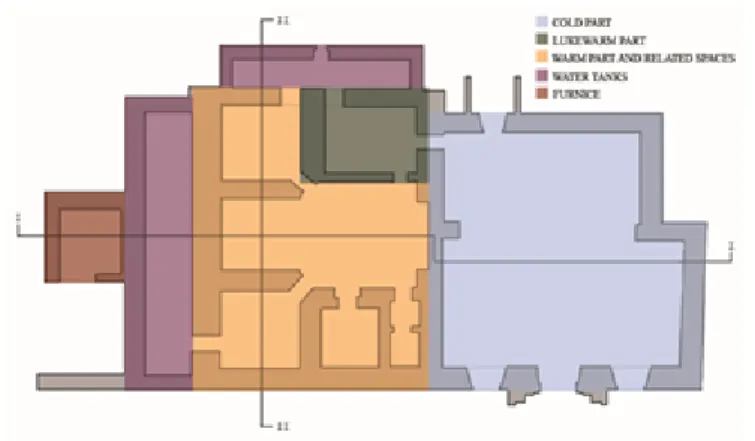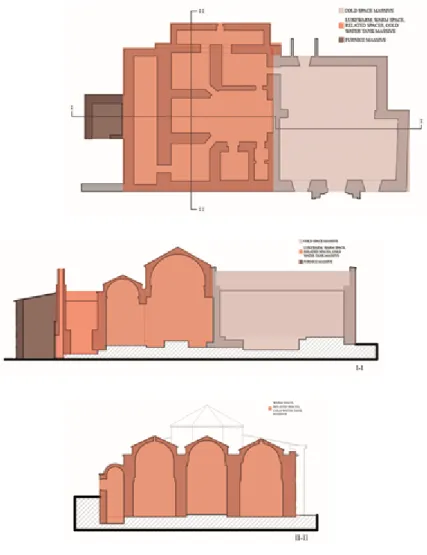IC
ON
A
RP
ICONARP International Journal of Architecture & Planning Received 25 March 2017; Accepted 10 November 2017 Volume 5, Special Issue, pp: 91-102/Published 18 December 2017
DOI: 10.15320/ICONARP.2017.28-E-ISSN: 2147-9380 Research Article
Abstract
Bergama is an important settlement center which have different civilizations. Today, it comes forward with especially the cultural heritage of Antiquity but there is an important heritage which has Ottoman period’s impress too. The works which reflect to aqua culture effectuate a part of that heritage. Especially Turkish bath buildings have an important place to remind and sustain that culture.
The aim of this study is making an essay in adaptive reuse via Küplü Hammam which is an important representative of Ottoman aqua culture in the urban memory. In this sense, Küplü Hammam will be examined in the context of its characteristic properties and it will be evaluated as spatial and volumetric flow to provide its characteristic properties’ sustainability. In this context, it is intended to develop some acceptable strategies for the building’s adaptive reuse. Thus, this study will contribute for the characteristic properties of the building to keeping alive them with protection and sustain their place in urban memory.
An Essay in Adaptive
Reuse: The Case of
Bergama Küplü Hammam
Tuba Nur Baz
*Müjgan Bahtiyar Karatosun
**Keywords: Küplü Hammam, conceptual
essay, adaptive reuse, urban memory *Research Assistant, Dokuz Eylül University, Departement of Architecture, İZMİR
E-mail: tuba.baz@deu.edu.tr
Orcid ID: http://orcid.org/0000-0001-5654-0020
**Associate Professor, Dokuz Eylül
University,.Departement.of Architecture,
İZMİR
E-mail: mujgan.bahtiyar@deu.edu.tr
Orcid.ID:.
N ARP. 20 17 .28 – E -I SSN : 21 47 -9380 INTRODUCTION
Aqua culture is an important part of urban memory. In this sense, Bergama, which is a district of İzmir, is an important settlement having a cultural heritage that reflects the urban memory with its deep aqua culture. Bergama, which houses many different civilizations, contains aqua culture heritages that reach daily from these civilizations. A significant part of this heritage is also the hammam buildings.
Antiquity and the Ottoman period was an important process in terms of the development and spread of hammam buildings. For this reason, many important hammam structures were built during Antiquity and during the Ottoman period. In this context, hammams in Bergama, which especially arrived from the Ottoman era on a daily basis, have great prospects in terms of reflecting the aqua culture and the memory of the city at that time. One of these buildings, Küplü Hammam, which reached the site from the Ottoman period in the settlement and reusing to host a different function; at the same time an important example emerges that reflects the aqua culture and urban memory of the time. But this reusing hammam was not able to continue functioning after a while and was not used.
This study examines the characteristics of the Küplü Hammam and aims to develop conceptual reading trials and suggestions for maintaining the sustainability of the new function and the permanence of the cultural memory. It is considered that the proposals will contribute to the sustainability of the new function by evaluating the spatial, volumetric and massive character of the hammam and contributing to the preservation of the place in the urban memory.
KÜPLÜ HAMMAM (THE HAMMAM WITH AN URN)
Küplü Hammam is located in Osman Bayatlı Street, beside İncirli Masjid and Taş Inn, Bergama, İzmir (Figure 1 - 2). In this location, Küplü Hammam is close to the city center of Bergama.
olu m e 5, Sp eci al Is sue / Pu bli shed : D ecemb er 2 01 7
The inscription of Küplü Hammam couldn’t be found. It was mentioned by Bayatlı that the hammam was built together with İncirli Masjid and Taş Inn. It was stated in a foundation registration which is belong to 1427 that the hammam was built and dedicated by Hibetullah who is the son of Hatib Mahmut Pasha (Bayatlı, 1956).
Küplü Hammam has this name because of the urn that was in the building (Figure 3). It is known that this urn is belong to Antiquity (Bayatlı, 1995). This suggests that the Ottomans used the urn in the bath as practicing adaptive reuse of the material culture of Antiquity. The urn has remained in the bath for about 400 years and was later given to the French by Sultan II. Mahmud. It is now exhibited in the Louvre Museum (Özdemir, 2009).
Figure.2..Küplü.Hammam’s
location on the map (Bergama Municipality archive / 2016).
Figure.3..The.urn.of.Küplü Hammam.(Bergama.Municipality archive/2016).
Figure 1. The location of Küplü
Hammam (Google Earth/ 2017).
N ARP. 20 17 .28 – E -I SSN : 21 47 -9380
The building material of Küplü Hammam is rubble stone and lime mortar (Bayatlı, 1956). The main entrance of the hammam is provided from the door on Osman Bayatlı Street (Figure 4). In addition, there was another entrance of hammam for women. Looking at the layout of the plan, it can be seen that the hammam consists of cold space, lukewarm space, warm space, three special washing cells, an eyvan, a toilet, furnice space and water tanks (Figure 5 - 6).
When passing the main entrance of the hammam, it reached the cold space. This space, which also serves as a welcoming place, is for preparing before washing and relaxing. The upper cover of this space is wood, but it was understood that it was covered with a dome earlier than the traces in the structure (Bayatlı, 1956). The floor material of the cold space is marble. On this floor, there is a pool in the middle of the space. In the cold space, there is a door
Figure 6. Sections of Küplü
Hammam.(Bergama.Municipality archive / 2016).
Figure 5. The plan of Küplü
Hammam.(Bergama.Municipality archive / 2016).
Figure 4. The entrance facade of
Küplü Hammam.
olu m e 5, Sp eci al Is sue / Pu bli shed : D ecemb er 2 01 7
near the small door that opens for women and it provides passing to the lukewarm part.
Lukewarm part provides passing between cold space and warm space. Also it is a relaxing space after washing. Its floor material is marble as like the cold part’s. There is a small door in the lukewarm space for passing to the warm space.
The warm space includes a central space where the navel stone is located, three special washing cells, an eyvan and a toilet. People can use the central space, eyvan or special washing cells to clean their bodies. But special washing cells that its name is ’’halvet’’ are suitable for small number of people. Other washing spaces can be used by many people in the same time. The upper cover of warm space is a big dome. There are domes on special washing cells, eyvan and toilet too. All of these domes have unique ornaments and decorations. All spaces in the warm space have marble as the floor material. They have marble tubs for accumulating water and use it during washing with copper bowls.
The heating system of the bath was formed by heat channels called hell roads passing under the floor as it is in many other Ottoman hammam buildings. The heat formed in the furnice space warms the hammam by spreading the hot spring through these channels. A chimney system has also been created for the release of air and the exchange of air in the space.
For the Ottoman hammams, the largest space as volume and mass is the cold space. After that the warm space follows the cold space as volume and mass. The lukewarm space is the smallest space of an Ottoman hammam. But in detail, special washing cells, eyvans and toilets can be smaller than the lukewarm space. In Küplü Hammam, this hierarchy is like many other Ottoman baths. One of the most important hammam building of the period, Küplü Hammam was used for a long time after various repairs and was abandoned after a while. There is not much to do from the well-worked marble elements that was in the hammam in the past inside. In addition, the interior of the hammam is completely plastered with concrete and covered with ceramic in some places (Özdemir, 2009).
The Küplü Hammam was registered with the decision of the Supreme Council for the Protection of Cultural and Natural Assets on 26.10.1984 and 466 numbered. The restoration project was prepared for the hammam which has not seen any intervention from the year of use shutdown until 2001and the application was made in 2008 and the reuse was opened with the function of cafe.
95
N ARP. 20 17 .28 – E -I SSN : 21 47 -9380
The restoration project of Küplü Hammam had been foreseen to continue to be used with its original function. But the building was located in a central location in Bergama, it was decided to reuse it as a cafe because it did not demand the hammam function. As Küplü Hammam Cafe, the hammam building which has been reused as a cafe and opened to use, has been used for a while with this function. During the time that the hammam was used with the cafe function, only the cold space was arranged for this function; other spaces are out of use. However, later this function could not continue and the building use was closed. Today it is open for special exhibitions at certain periods of the year.
Given the inappropriate function of the building, the maintenance of this function has caused especially economic problems in the building. In addition, the fact that the structure can not be evaluated together with its surroundings and is not arranged to be compatible with the characteristics of the structure of the given new function has been an important factor in its inability to continue its use. Because of these reasons, the building that closed is unprotected under natural conditions because it is not maintained even if it is used for a short period during certain periods of the year. Depending on this, some deterioration in the structure, which is based on natural causes, also started to occur. AN ESSAY IN ADAPTIVE REUSE FOR KÜPLÜ HAMMAM
The reasons for adaptive reuse of monument structures can be summarized as the loss of their original function or as functionally obsolete (Altınoluk, 1998). The restructured constructions continue to reflect the symbolic and original places in the memory as well as transfer them to future generations by preserving their aesthetic, social, artistic and spiritual characteristics (Throsby, 2006; Madran, Özgönül, 2005; Aydin, 2010). From this point of view, the original function is functions such as education, health, industry or other public use that it has a positive effect in terms of loading new functions to them for maintaining the structures, transferring them to future generations and preserving their place in the urban memory (Ahunbay, 2013). In this context, the adaptive reusing of the Küplü Hammam can be regarded as a positive approach in terms of protection. However, in order for the new function given to the structure to be sustainable and to be able to maintain its place in the urban memory with both its original and new function, some characteristic features must be taken into account. These characteristics are especially spatial, volumetric and massive in nature of the structure. In this sense, for the new function to be given Küplü Hammam;
olu m e 5, Sp eci al Is sue / Pu bli shed : D ecemb er 2 01 7 • Spatial
- Spatial fluidity and hierarchy • Volumetric
- Volumetric fluidity and hierarchy • Massive
- Massive hierarchy
factors should be investigated and a new function should be developed to protect the character of the structure.
Küplü Hammam has own special characteristic spatial layout. For this reason, the spaces of the new function that will be given to the hammam should be observed and organized considering the original spatial characteristic of the structure. In this context, reading Küplü Hammam’s spatial fluidity and hierarchy graphics will be effective. If the spatial fluidity to be created by the new function to be given is compatible with the original spatial fluidity graph of the building, this function will be stronger both in the sense of sustainability and in the spatial memory (Figure 7-8-9-10).
Figure 7. Spatial fluidity plan
graphic of Küplü Hammam.
Figure 8. Spatial fluidity section
graphics of Küplü Hammam.
N ARP. 20 17 .28 – E -I SSN : 21 47 -9380
Küplü Hammam has an original qualification as volumetric. There are main volumes and a passing volume to provide the transition between the two main volumes. All these volumes are supported with related volumes and all together, they form a total volume. So when the structure will be reused, this volumetric characteristic should be used in accordance with its original state. The adaptation of the new function to the volumetric partition and hierarchy of the structure will also support the place in memory of the structure by preventing the volumes contained therein from being left idle or having more volume than can have a volume (Figure 11-12-13-14).
Figure 9. Spatial hierarchy plan
graphic of Küplü Hammam.
Figure.10..Spatial.hierarchy
section.graphics.of.Küplü Hammam.
olu m e 5, Sp eci al Is sue / Pu bli shed : D ecemb er 2 01 7
Figure 11. Volumetric fluidity plan
graphic of Küplü Hammam.
Figure 12. Volumetric fluidity
section.graphics.of.Küplü Hammam.
Figure 13. Volumetric hierarchy
plan graphic of Küplü Hammam.
99
9
N ARP. 20 17 .28 – E -I SSN : 21 47 -9380
The mass is an important parameter in the functional formation of the structure. May be the case that the mass, including spaces and volumes, is lost in its characterisrtic if it is not judged by correct functioning. In this sense, especially the massive hierarchy as vertical and horizontal is very important to decide for a new function as sustainable on the Küplü Hammam structure. The division of massive parts of the structure and the total effort to use the divided masses must first be considered by considering how the memory of the place as a bath will be affected and a suitable function must be provided (Figure 15-16).
Figure 14. Volumetric hierarchy
section.graphics.of.Küplü Hammam.
Figure 15. Massive hierarchy plan
graphic of Küplü Hammam.
Figure.16..Massive.hierarchy
section.graphics.of.Küplü Hammam.
olu m e 5, Sp eci al Is sue / Pu bli shed : D ecemb er 2 01 7
CONCLUSIONS AND RECOMMENDATIONS
The memory of place is a complex concept that contains many tangible and intangible data. One of these statements as tangible and intangible in the same time is historical buildings in the city. Bergama, which has a wide memory in this context, has many important historical buildings. The hammams, which are the important historical buildings that Bergama has in the forefront of aqua culture, are important in terms of reflecting the city's memory.
Küplü Hammam is one of the important structures reflecting the memory of the city over the aqua culture in Bergama. Küplü Hammam, which has an important place in the urban memory both structurally and in terms of usage, also has a special characteristic as an Ottoman period hammam structure. For this reason, it is important to assess the structure in both an environmental sense and to read its own characteristic, in order to protect its place in memory.
In this study, evaluating of the characteristic features of the Küplü Hammam as concept was done. This essay contains the massive, volumetric and spatial features that make up the basic character of the structure. The essays were reconciled with the reuse of the Küplü Hammam and the maintenance of this function; thus trying to clarify the features that it has in the sense of place memory. In this context, it is considered that the new function which will be given to the structure by examining the characteristic features of the structure will contribute to transfer the memory of the place to future generations by protecting this characteristic.
ACKNOWLEDGEMENT
This article is prepared by expanding the proceeding presented in the ICONARCH III, held at Selçuk University in May 11th-13th, 2017.
REFERENCES
Ahunbay, Z. (2013). “2013’ün Tartışmalı Yeniden Kullanım ve İhyaları.”.Mimarlık.Dergisi,.374..Retrieved.from.http://ww w.mimarlikdergisi.com/index.cfm?sayfa=mimarlik&DergiS ayi=388&RecID=3322 (15 December.2015)
Altınoluk, Ü. (1998). Binaların Yeniden Kullanımı. İstanbul: Yapı Endüstri Merkezi Yayınları.
Aydın, D. (2010). Socio-cultural Sustainability And An Assessing Model For Reuse Adaptation. Central Europe Towards Sustainable Building, Prague, Czech Republic.
Bayatlı, O. (1956). Bergama Tarihinde Türk-İslam Eserleri. İzmir: Bergama Belediyesi Kültür Yayınları.
N ARP. 20 17 .28 – E -I SSN : 21 47 -9380
Bayatlı, O. (1995). Küplü Hamam. İzmir: Bergama Belediyesi Kültür Yayınları.
Bergama Municipality Photo and Project Archive. (2016). Google Earth. (2017).
Madran, E. and Özgönül, N. (2005). Kültürel ve Doğal Değerlerin Korunması. Ankara: Chamber of Architects.
Özdemir, H. (2009). Bergama’da Türk-İslam Mimarisi. İzmir: İzmir İl Özel İdaresi Yayınları.
Throsby, D. (2006). “The Value of Cultural Heritage: What Can Economics Tell Us? Capturing The Public Value of Heritage.” Capturing the Public Value of Heritage Conference, 25-26 January 2006, pp. 40-43, London.
Resume
Tuba Nur Baz completed Yildiz Technical University, faculty of architecture, architecture undergraduate program in 2014. She worked in Ernur Architecture in 2014, Foça excavation presidency and mastar architecture in 2015 as an architect. She worked in Firat University, faculty of architecture, restoration department as a research assisstant in 2016. She continues to work in Dokuz Eylul University, faculty of architecture, restoration department as a research assisstant. Her doctoral education continues in same department.
Mujgan Bahtiyar Karatosun completed Dokuz Eylul University, faculty of architecture, architecture undergraduate program in 1995. She completed her master education in Dokuz Eylul University, natural and applied science institute, restoration program and got her doctorate degree in same department in 2004. She got the title of associate professor in 2012. She continues to work in Dokuz Eylul University, faculty of architecture,
restoration department as a faculty member.
